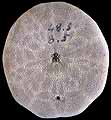The Echinoid Directory
Peronella Gray, 1855, p. 13
[?= Lambertiella Checchia-Rispoli, 1917, p. 57, type species L. pulchra Checchia Rispoli. 1917 ]
| Diagnostic Features |
|
|---|---|
| Distribution | Recent of the Indo-Pacific. |
| Name gender | feminine |
| Type | Laganum peronii L. Agassiz, 1841, p. 123, by original designation. |
| Species Included |
|
| Classification and/or Status |
|
| Remarks |
|




